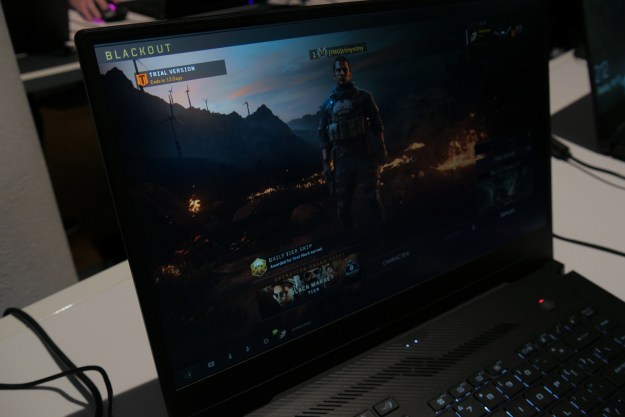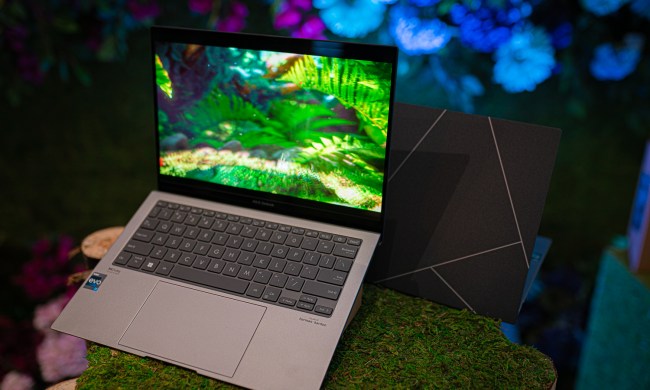
“The ROG Zephyrus S GX502’s 240Hz screen makes for a buttery smooth gaming experience.”
- Thin, light design
- Super fast 240Hz refresh rate screen
- New material feels premium
- Overclocked RTX 2070 graphics
- Latest 9th-gen Intel CPU
- No webcam
- Awkward keyboard layout
Asus claims ROG is the best-selling gaming laptop brand in the world. It’s not hard to see why. They’re powerful laptops that often have a more affordable price than the competition. At the top of that brand is the Zephyrus S line, which includes Asus’ most extreme gaming laptops.
At a preview event in New York, we went hands-on with the new Zephyrus S GX502, along with a string of other
A Zephyrus without compromises
If you’re up to date with
This new Zephyrus, the GX502, takes a more conventional approach. The keyboard and touchpad are right where you’d expect them to be. It looks more like a standard gaming laptop, and that’s a good thing. The device is sturdy and made from a reinforced magnesium alloy chassis with a soft touch finish. The texture feels good under your fingers and doesn’t pick up fingerprints as easily as the Razer Blade.
Speaking of the Razer Blade, the Zephyrus S GX502 competes in terms of portability. It’s equally thin at just 0.7 inches, and it’s a third of a pound lighter than the Blade at just 4.19 pounds. You’ll feel the heft when you throw this in your backpack, but it’s only a tiny bit heavier than a Dell XPS 15.

While it’s more conventional than the GX701, the GX502 does borrow one important feature. It has the same bottom vent that lifts when you open the lid. Popping it open provides extra airflow. You’ll also find vents located on the sides, above the ports.
Your selection includes an HDMI port, an ethernet jack, a USB-A port, and separated headphone and mic jacks. On the right side are two USB-A ports and a USB-C/
The webcam isn’t under the display or hidden under a key. It’s just gone.
Another feature the GX502 has picked up from the GX701 is its super slim screen bezels. They’re so slim, in fact, that the webcam has disappeared entirely. It’s not hidden under the display or under the keyboard. It’s just gone. This is a strange decision, but Asus seems set on this solution and is implementing it across its entire lineup of new
The GX502 can also toggle between G-Sync and Optimus. G-Sync is Nvidia’s adaptive sync technology that prevents screen tearing, which makes games look smooth at higher framerates. However, it kills battery life fast because it requires the GPU be engaged at all times. Optimus mode allows the system to switch between the Nvidia GPU and Intel integrated graphics, meaning you’ll save hours on battery life when you aren’t gaming. Past

It’s a brilliant feature on the surface, but in practice, we think less people will use it than Asus hopes. It can be found in ROG Armoury settings, but requires a system restart to switch. That’s not ideal, even if switching out of G-Sync mode adds significant runtime to the 70-watt hour battery.
Not everything the GX502 learned from the GX701 is positive. Some keyboard quirks have made the transition. The keys you’d typically find in the function row have been split up and moved to a few different places, including above and to the side of it. The Print Screen key has even been relocated down between the Alt and Ctrl keys.
The unit we previewed was using a UK International layout, swapping the secondary functions of the “2” and apostrophe keys. This also means the left Shift key has been cut in half to make room for a backslash key.
The touchpad is a big improvement over previous models. It’s large and responsive, and even the click mechanism feels solid. The lighting is handled by ROG’s AuraSync technology, which provides per-key RGB backlighting with plenty of room for customization.
Is 240Hz overkill?
You might wonder what in the world you would do with a 240Hz refresh rate on a laptop. We had the same question, but Asus has insisted that for the right player, a refresh rate of 240Hz can make a difference. Esports, as usual, the excuse for Asus’ madness.
Most games will only run above 200 FPS at low detail, and plenty of games have built-in framerate caps. So yeah, it’s overkill. But the extra speed doesn’t have a drawback, and it’ll set you up for the future. I sampled some Call of Duty: Black Ops 4 on the screen, and I was pleased by what I saw, though I couldn’t easily spot the difference between 240Hz and 144Hz.

When comparing performance on
The Zephyrus S GX502 drops the presumptions and includes a simple RTX 2070. No Max-Q. Just a 2070 that uses Asus’ ROG Boost to push it up to 1,540MHz at 115 watts. That means it should be more powerful than other RTX 2070 implementations out there. The Zephyrus S GX701 with its RTX 2080 will no doubt push out higher frames per second, however.
On the processor side, the GX502 puts to use Intel’s latest 9th-gen Core i7-9750H CPU. It’s a six-core processor with slightly faster clock speeds of last year’s version. The Core i9-9890H is missing here, as well as the Core i7-9850H which can come partially unlocked. That said, the 9750H provides a modest bump in clock speed over last year’s models.
The GX502 also comes with 16GB of
Configurations galore
In addition to the Zephyrus S GX502, Asus has announced the Zephyrus M GU502 and Zephyrus G GA502. These
The GU502 uses an RTX 2060, while the GA502 uses a GTX 1660 Ti and AMD Ryzen 7 3750H processor. We don’t know much about that GTX 1660 Ti GPU just yet, but it’s helping Asus sell the GA502 at just $1,199. That configuration comes also comes with 16GB of
All three


